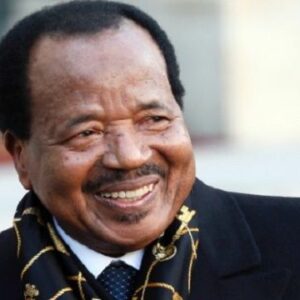Since 1982, Paul Biya, sometimes known as Cameroon’s “lion man,” has served as the country’s president. He is one of the African continent’s longest-serving leaders. After his predecessor, Ahmadou Ahidjo, unexpectedly resigned, the octogenarian has been controlling the West African country. Despite being inspired to become a priest as a boy by the Catholic missionaries in his area, he chose to educate himself in Paris and return to his village to enter the civil service. He progressed to numerous ranks and senior positions as a result of his perseverance, devotion, and hard work, eventually becoming the Prime Minister of Cameroon. After that, he became President, but while in office, he modified the country’s governing techniques and imposed autocratic authority. Despite having a good commercial relationship with other countries, he has failed to improve Cameroon’s economic situation, owing to his incapacity to exercise adequate power, management, and peaceful political change. Today, American populist historian David Wallechinsky ranks him among the world’s top 20 worst dictators, among the leaders of other sub-Saharan African countries such as Zimbabwe, Equatorial Guinea, and Swaziland.
Childhood and Adolescence
Paul Biya was born on February 13, 1933, as Paul Barthelemy Biya’a bi Mvondo, into a humble household in Mvomeka’a village, South Region French Cameroon, to Etienne Mvondo Assam and Anastasie Eyenga Elle. When he was seven years old, he went to the Catholic mission in Ndem. His French professor advised he become a priest after seeing his good performance, and he was enrolled in Edea and Akono Junior Seminaries at the age of 14.
He transferred to Yaoundé’s Lycee General Leclerc, a high-class secondary school where he studied Greek, Latin, and philosophy, among other disciplines. He went to the University of Paris to study law and political science after graduating from high school. In 1960, he received his law degree. He then went on to the Institute of Overseas Studies to study public law.
He was put in-charge of the Department of Foreign Development Aid upon his return to Cameroon in 1962, reporting directly to President Ahmadou Ahidjo. Despite their differing backgrounds and dispositions, Ahidjo became his political mentor, serving as director of the cabinet, general secretary of the presidency, and minister of state under him.
In 1975, Ahidjo selected him as Prime Minister of Cameroon. Following Ahidjo’s unexpected resignation in 1982, Biya was elected President. In January 1984, he conducted presidential elections and was re-elected as President.
Ahidjo was arrested and tried for his role in two military coup attempts on Biya in August 1983 and April 1984, and was sentenced to life in prison.
As President of the Cameroon People’s Democratic Movement (CPDM), he disbanded CNU and founded a new party, the Cameroon People’s Democratic Movement (CPDM). During his presidency, he took significant steps to improve Cameroon’s economic situation; however, the country began to experience an economic crisis in 1987, which hampered the sale of the country’s natural resources and lasted until 1996.
In the 1988 presidential elections, he was re-elected for a second term. Due to increasing pressure from his compatriots, he allowed the formation of opposition parties during this time. In 1992, the first multiparty elections were held, with John Fru Ndi of the Social Democratic Front as the opposition candidate (SDF). Despite the fact that officially indicate Fru Ndi was the winner, Biya declared himself the winner.
Fru Ndi and other opposition parties boycotted the 1997 presidential elections, claiming they were rigged. As a result, Biya won the election and was re-elected President. He made accords with Chad, the United States, and China to improve his country’s economic status. Despite the fact that imports and exports began to increase, the situation in Cameroon remained unresolved.
Despite opposition parties’ claims that the 2004 presidential elections were rigged, he won and was sworn in for a fifth term. The political situation in Cameroon has become unstable, owing to ongoing issues between Francophones and Anglophones. When Biya came to power, however, he chose to protect Francophones and took no steps to address the problems.
Realizing he would be unable to run for President in 2011 due to the two-term restriction, he chose to modify the 1996 Constitution, arguing it was unfair in limiting people’s choices, in order to ensure he remained in power. Despite violent protests calling for the rewriting of the Constitution to be canceled, the National Assembly agreed to make revisions in 2008. He also received immunity from any possible prosecution after stepping down as President.
He was ranked 19th in Parade Magazine’s Top 20 list of “The World’s Worst Dictators” in 2009. He was elected President of Cameroon for the sixth time in 2011 elections. He is also the National President of CPDM, a position he has held from the organization’s founding in 1985.
Major Projects of Paul Biya
He is best known for resolving a dispute with his neighbor, Nigeria, over the oil-rich Bakassi Peninsula by petitioning the International Court of Justice and signing the Greentree Agreement with the Nigerian government in 2006.
Personal History and Legacy
In 1960, he married Jeanne-Irene. They didn’t have any children together, but she adopted Frank Biya, a child from Biya’s extramarital affair. He remarried Chantal Biya, 38 years his junior, in April 1994, after Jeanne’s untimely death in July 1992. Paul Biya Junior and Anastasia Brenda Biya Eyenga are the couple’s two children. The first couple of Cameroon is often in the news, owing to their extravagant lifestyle. He owns two Boeing 747 presidential jets, two private villas in Cameroon, and other properties in Switzerland and France.
Estimated Net Worth
Paul Biya is a Cameroonian politician who has a net worth of $200 million. Born Paul Barthélemy Biya’a bi Mvondo on 13 February 1933, in Mvomeka’a, French Cameroons (now Cameroon), he has served as the President of Cameroon for more than 38 years, holding the post since November 6, 1982.


